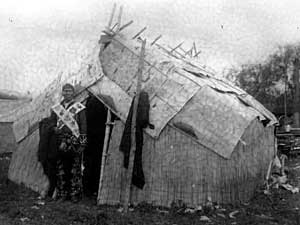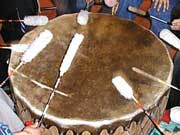Part 3: Christianizing the Indians
August 20, 2003
 |
| A medicine lodge on the White Earth Reservation -- date unknown. Indian spiritual practices were banned on reservations for decades in the late 1800s and early 1900s. (Photo courtesy of Becker County Historical Society) |
White Earth Reservation — Years of repression caused many Indian people to lose touch with traditional ways. Worship was illegal for generations of Indians.
The federal government banned ceremonies in the late 1800s and early 1900s. In 1882, Commissioner of Indian Affairs Hiram Price wrote a letter expressing U.S. government policy toward Indian religious freedom.
"There is no good reason why an Indian should be permitted to indulge in practices which are alike repugnant to common decency and morality. The preservation of good order on reservations demands of me active measures be taken to discourage -- and if possible, put a stop -- to the demoralizing influence of heathenish rites," Price's letter said.
 | |||
The government also called for a "careful propaganda to educate public opinion against the Indian religious dance."
Violators were punished under regulations called "Indian offenses." Food rations were withheld. People were jailed. Children were taken from parents and sent to government boarding schools. Indian spirituality went underground. The White Earth Reservation was typical.
"In 1875 they banned all drumming, singing and dancing for anyone 50 years and younger," says Andy Favorite, the tribe's historian. "When the old people died, that stuff died with it. What we have is bits and pieces. People hid in the brush and did ceremonies. They were punished. I know elders who did time in prison for praying with a pipe in the 1960s. The FBI, the BIA were looking for people practicing pagan. Oh, my God. Pagan stuff."
In some areas American Indian spiritual ceremonies were illegal until 1978, when Congress passed The American Indian Religious Freedom Act.
The law has changed, but the fear of religious persecution still haunts some American Indian people. Michael Dahl, a young spiritual leader on the White Earth Reservation, remembers how his grandfather was traumatized.
|
It was conversion of the stomach. I want to eat, so I'll get baptized so I can get my issue, or I'll get baptized so I can get a house.
- Andy Favorite, White Earth tribal historian |
"That old man used to sit and tell stories. Where we grew up out in the country, seven miles outside of town, he was much more relaxed. My aunt lived in town. For him to talk there, close all the windows, lock the doors, pull the shades. And that old man would still whisper," Dahl recalls. "'Grandpa why are you whispering?' 'Because I don't want them to hear. I don't want them to come and get you.' That's what he would say. He was 77 years old when he died, and he was still afraid of somebody coming and taking his great-grandkids."
Churches and the federal government worked hand in hand to Christianize and civilize American Indians. Churches were given authority to distribute aid and run reservation social programs.
Missionaries worked to discredit traditional beliefs. They called Indians savages and pagans. People were punished for performing ceremonies, or even wearing traditional clothing.
The experience left many Indians deeply embittered. Josephine Robinson's parents were members of the Grand Medicine lodge on the Leech Lake Reservation. The lodge was where ceremonies were held in secret.
Robinson was interviewed in 1963 -- when Indian ceremonies were still illegal.
"They call us Indians pagans. There never was such a thing as a pagan Indian. We always believed in the Spirit above. I was taught that from the time I was a little baby. And all these Grand Medicine people believed in God. I can't understand why they come here and call us pagans," Robinson said in 1963.
 | |||
Many Indians are still suspicious of anything that has to do with the Christian church.
"Shame-based Christianity was used as a tool to colonize us," says White Earth tribal historian Andy Favorite.
"The churches were using the government and the government was using the churches. It was supposedly for our soul, but the big carrot was the land and the resources," he says.
Favorite says many Indians converted to whatever religion was practiced by the Indian agent. Indians were often baptized for practical, rather than spiritual, reasons.
"It was conversion of the stomach. I want to eat, so I'll get baptized so I can get my issue, or I'll get baptized so I can get a house," Favorite says. "If you didn't have a baptismal record or a marriage license that meant you didn't get blankets, food and money that was guaranteed by the treaties."
Andy Favorite says he has no doubt many of the early missionaries were sincere. They clearly felt Indian beliefs were inferior to western religion.
"They were doing what they thought was right. You have to get in their head. They encountered these people that were part naked. And that wasn't OK. And you could have multiple wives," says Favorite. "Think of how appalling that must have been to them. It must have been a super mega-cultural clash, and it's been a clash ever since." It's hard to know how much traditional Indian belief has been changed by exposure to Christianity. Indians have no documents detailing the beliefs of their forefathers. The sacred word is passed orally from generation to generation.
Some believe the Christian message has slipped into Indian stories. They worry the original Anishinaabe spirituality has been diluted.
Over the years, Christianity and Indian culture blended in some unusual ways. One example was the Ojibwe Bible Hour, which aired on a Cass Lake radio station from the 1950s through the early '70s. The Christian Gospel message was presented in the Ojibwe language.
Ironically, most Ojibwe today wouldn't understand that Gospel message. Few are fluent in their own language.
Christianity and Indian culture still mix in many Minnesota tribal communities. The Ojibwe Hymn Singers often are called on to provide music at American Indian funerals.
Sometimes a priest and an Indian spiritual leader walk down the aisle together at Indian burial services. But in some communities, families are forced to choose.
Some churches encourage Indians to bring their traditions into the church. Other parishes reject all Indian symbols and ceremonies. Indian people are deeply divided over whether the Christian church and traditional beliefs can coexist.
|
News Headlines
|
Related Subjects
|

